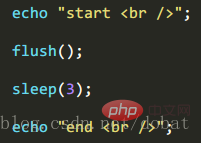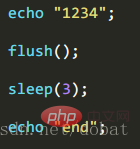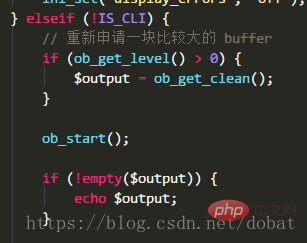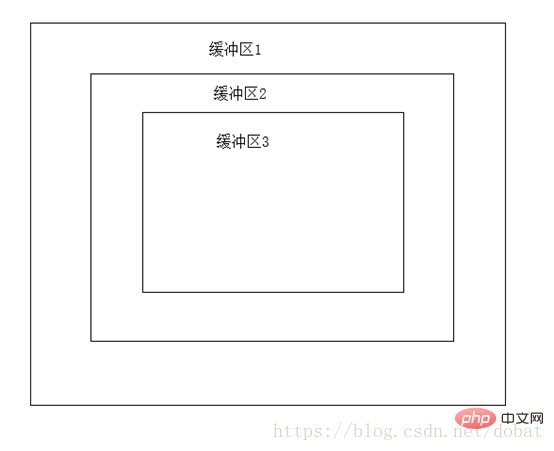How to close buffer in php
php method to close the buffer: 1. Open the PHP installation directory, find and open the configuration file "php.ini"; 2. In the configuration file, find the "output_buffering" item, and set the value of this item Just set it to "Off".

The operating environment of this tutorial: windows7 system, PHP7.1 version, DELL G3 computer
PHP buffer ( buffer)
The script output information is first put into the buffer. Only when the buffer is full or the script is finished running, the data will be transferred to the next stage. You can find the output_buffering setting item in the configuration file php.ini. My default configuration (Windows/XAMPP v3.2.2) is 4096

If set to On, the buffer is available and has no size limit;
If set to Off, the buffer is unavailable;
If set to an integer, the buffer The area is available and is the set size, in bytes.
It should be noted that ini_set cannot set the buffer size. When initializing the script running environment, the buffer has been defined; in cli mode, the default output_buffering is Off. .
Then the question is, what is the difference between closing and opening the buffer? What does the initial buffer size do? The cli mode is turned off by default. Can it be turned on if business needs it? What are the benefits of the cache area?
1. What is the difference between closing and opening the buffer?
Pass code inspection
When output_buffering is configured as 4096, run the code

Output result: After waiting for 3 seconds , output start and end at the same time
When Output_buffering is configured as Off, run the same code
The output result: start is output first, and after waiting for 3 seconds, end
## is output #Looking at it alone, the results are exactly the same~ But observing its operation process, I found surprising differences. If buffering is turned off, "start" is output first, and then "end" is output after waiting for 3 seconds. When the buffer is turned on, it will wait for the script execution to complete and output the results together In this example, flush is used to refresh the apache buffer, similar to allowing the PHP buffer to establish a direct connection with the browser, so that our attention Be able to focus on the PHP buffer itself. Through a vivid example, PHP's buffer is like a big house. Every time the output function such as echo is executed, the data is thrown into this big house until the script execution is completed or the ob_flush function is executed. The data is released from the big house and thrown into the WebServer buffer. After closing the PHP buffer, the echo function is executed. What should I do if there is no big house to put it in? I have to hand it over directly to the WebServer buffer. Through examples and code execution results, we can understand that the so-called PHP buffer is a data storage hub developed by PHP itself, and a series of ob functions operate for this purpose. (Cite a few example functions) ob_clean(); //Delete the contents of the internal buffer, do not close the buffer (no output). ob_end_clean(); //Delete the contents of the internal buffer and close the buffer (no output). ob_get_contents(); //Returns the contents of the buffer, does not output ob_get_length(); //Returns the length of the internal buffer. If the buffer is not activated, this function returns FALSE .2. What is the role of the initial buffer size?
Change output_buffering from 4096 to 5 to facilitate test executionExecution code

3. The cli mode is turned off by default. Can it be turned on if business needs it?
This question can be supplemented. In non-cli mode, if php.ini sets the buffer to be closed, but the business needs to use the buffer, what should I do? Is it possible to change the configuration? Of course it won't be that difficult. At this time, another ob function comes, ob_start(); //Open an output buffer. All output information is no longer sent directly to the browser, but saved inside the output buffer. Now that we know that PHP buffer is similar to the concept of temporary data storage area, let’s go back and look at the TP5 source code.
Let’s first look at the explanation of ob_get_level and ob_get_clean functions
ob_get_level(): Returns the nesting level of the output buffering mechanism.
ob_get_clean(): Get the contents of the current buffer and delete the current output buffer.
We can also learn a thing or two from the code. If the level is greater than 0, get the contents of the buffer and delete the buffer, and then open a new one through ob_start. This is also in line with the instructions in the comments. "reapply".
The so-called nesting is explained here. As for when the value of level will be 0, and what is it if it is non-0, please turn off php.ini output_buffering and output to see the result. In addition, ob_start multiple times and ob_get_level multiple times, let’s try to compare the output results.
Let’s take a look at the two models first


4. What are the benefits of the cache area?
PHP output data is sent to WebServer. If echo is executed and sent once, this increases resource consumption. It is more efficient to store it in memory and send it uniformly. Web requests contain HTTP headers, and there must be no output before the headers are set. The PHP buffer does this work for us, outputting various data before sending the header. The buffer will first send the header information to WebSever, and then send the data packets uniformly. Recommended learning: "PHP Video Tutorial"
The above is the detailed content of How to close buffer in php. For more information, please follow other related articles on the PHP Chinese website!

Hot AI Tools

Undresser.AI Undress
AI-powered app for creating realistic nude photos

AI Clothes Remover
Online AI tool for removing clothes from photos.

Undress AI Tool
Undress images for free

Clothoff.io
AI clothes remover

Video Face Swap
Swap faces in any video effortlessly with our completely free AI face swap tool!

Hot Article

Hot Tools

Notepad++7.3.1
Easy-to-use and free code editor

SublimeText3 Chinese version
Chinese version, very easy to use

Zend Studio 13.0.1
Powerful PHP integrated development environment

Dreamweaver CS6
Visual web development tools

SublimeText3 Mac version
God-level code editing software (SublimeText3)

Hot Topics
 1386
1386
 52
52
 PHP 8.4 Installation and Upgrade guide for Ubuntu and Debian
Dec 24, 2024 pm 04:42 PM
PHP 8.4 Installation and Upgrade guide for Ubuntu and Debian
Dec 24, 2024 pm 04:42 PM
PHP 8.4 brings several new features, security improvements, and performance improvements with healthy amounts of feature deprecations and removals. This guide explains how to install PHP 8.4 or upgrade to PHP 8.4 on Ubuntu, Debian, or their derivati
 How To Set Up Visual Studio Code (VS Code) for PHP Development
Dec 20, 2024 am 11:31 AM
How To Set Up Visual Studio Code (VS Code) for PHP Development
Dec 20, 2024 am 11:31 AM
Visual Studio Code, also known as VS Code, is a free source code editor — or integrated development environment (IDE) — available for all major operating systems. With a large collection of extensions for many programming languages, VS Code can be c
 7 PHP Functions I Regret I Didn't Know Before
Nov 13, 2024 am 09:42 AM
7 PHP Functions I Regret I Didn't Know Before
Nov 13, 2024 am 09:42 AM
If you are an experienced PHP developer, you might have the feeling that you’ve been there and done that already.You have developed a significant number of applications, debugged millions of lines of code, and tweaked a bunch of scripts to achieve op
 How do you parse and process HTML/XML in PHP?
Feb 07, 2025 am 11:57 AM
How do you parse and process HTML/XML in PHP?
Feb 07, 2025 am 11:57 AM
This tutorial demonstrates how to efficiently process XML documents using PHP. XML (eXtensible Markup Language) is a versatile text-based markup language designed for both human readability and machine parsing. It's commonly used for data storage an
 Explain JSON Web Tokens (JWT) and their use case in PHP APIs.
Apr 05, 2025 am 12:04 AM
Explain JSON Web Tokens (JWT) and their use case in PHP APIs.
Apr 05, 2025 am 12:04 AM
JWT is an open standard based on JSON, used to securely transmit information between parties, mainly for identity authentication and information exchange. 1. JWT consists of three parts: Header, Payload and Signature. 2. The working principle of JWT includes three steps: generating JWT, verifying JWT and parsing Payload. 3. When using JWT for authentication in PHP, JWT can be generated and verified, and user role and permission information can be included in advanced usage. 4. Common errors include signature verification failure, token expiration, and payload oversized. Debugging skills include using debugging tools and logging. 5. Performance optimization and best practices include using appropriate signature algorithms, setting validity periods reasonably,
 PHP Program to Count Vowels in a String
Feb 07, 2025 pm 12:12 PM
PHP Program to Count Vowels in a String
Feb 07, 2025 pm 12:12 PM
A string is a sequence of characters, including letters, numbers, and symbols. This tutorial will learn how to calculate the number of vowels in a given string in PHP using different methods. The vowels in English are a, e, i, o, u, and they can be uppercase or lowercase. What is a vowel? Vowels are alphabetic characters that represent a specific pronunciation. There are five vowels in English, including uppercase and lowercase: a, e, i, o, u Example 1 Input: String = "Tutorialspoint" Output: 6 explain The vowels in the string "Tutorialspoint" are u, o, i, a, o, i. There are 6 yuan in total
 Explain late static binding in PHP (static::).
Apr 03, 2025 am 12:04 AM
Explain late static binding in PHP (static::).
Apr 03, 2025 am 12:04 AM
Static binding (static::) implements late static binding (LSB) in PHP, allowing calling classes to be referenced in static contexts rather than defining classes. 1) The parsing process is performed at runtime, 2) Look up the call class in the inheritance relationship, 3) It may bring performance overhead.
 What are PHP magic methods (__construct, __destruct, __call, __get, __set, etc.) and provide use cases?
Apr 03, 2025 am 12:03 AM
What are PHP magic methods (__construct, __destruct, __call, __get, __set, etc.) and provide use cases?
Apr 03, 2025 am 12:03 AM
What are the magic methods of PHP? PHP's magic methods include: 1.\_\_construct, used to initialize objects; 2.\_\_destruct, used to clean up resources; 3.\_\_call, handle non-existent method calls; 4.\_\_get, implement dynamic attribute access; 5.\_\_set, implement dynamic attribute settings. These methods are automatically called in certain situations, improving code flexibility and efficiency.




